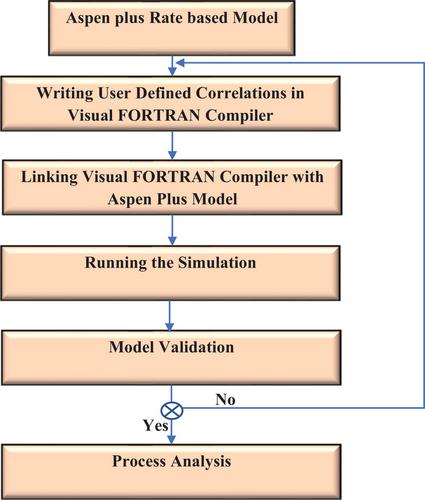下载PDF
{"title":"Performance study on mixed solvent for post-combustion carbon capture using rotating packed bed technology","authors":"Atuman Samaila Joel, Umar Farouk Aliyu, Olumide Olu Olubajo, Yusuf Makarfi Isa","doi":"10.1002/ghg.2280","DOIUrl":null,"url":null,"abstract":"<p>Modeling of CO<sub>2</sub> removal in a rotating packed bed using a mixed amine solution of piperazine and methyldiethanolamine with various molar concentration ratios was done with Aspen Plus<sup>®</sup> and dynamically linked with Intel<sup>®</sup> Visual Fortran. In addition to the mass and energy balances, all the necessary correlations for the rotating packed bed were written in Intel<sup>®</sup> Visual Fortran. The developed model was validated, and the result showed good agreement with a percentage error of less than 10%. The model was scaled-up to absorb CO<sub>2</sub> from the flue gas composition of a typical 6.4 MWe biomass power plant with the goal of producing net negative CO<sub>2</sub> emissions. The effect of process parameters such as temperature, rotation speed, liquid-gas ratio, methyl diethanolamine concentration, and piperazine concentration on capture efficiency and regeneration energy was investigated. It was discovered that increasing the rotational speed results in an improvement in the separation efficiency. Increasing the temperature of the lean solvent causes a decrease in separation efficiency, which is due to a decrease in solubility as the temperature increases. Increasing the liquid-to-gas ratio leads to an increase in CO<sub>2</sub> absorption efficiency because more hydroxide ions are present to react with the CO<sub>2</sub>. Piperazine is a reactive compound and increasing its concentration in the mixed solvent leads to an increase in CO<sub>2</sub> absorption efficiency. Finally, the results of the study demonstrated that a solvent mixture consisting of piperazine and methyldiethanolamine has the potential to be utilized in post-combustion CO<sub>2</sub> capture using rotating packed bed technology. © 2024 Society of Chemical Industry and John Wiley & Sons, Ltd.</p>","PeriodicalId":12796,"journal":{"name":"Greenhouse Gases: Science and Technology","volume":"14 3","pages":"400-410"},"PeriodicalIF":2.7000,"publicationDate":"2024-05-13","publicationTypes":"Journal Article","fieldsOfStudy":null,"isOpenAccess":false,"openAccessPdf":"https://onlinelibrary.wiley.com/doi/epdf/10.1002/ghg.2280","citationCount":"0","resultStr":null,"platform":"Semanticscholar","paperid":null,"PeriodicalName":"Greenhouse Gases: Science and Technology","FirstCategoryId":"93","ListUrlMain":"https://onlinelibrary.wiley.com/doi/10.1002/ghg.2280","RegionNum":4,"RegionCategory":"环境科学与生态学","ArticlePicture":[],"TitleCN":null,"AbstractTextCN":null,"PMCID":null,"EPubDate":"","PubModel":"","JCR":"Q3","JCRName":"ENERGY & FUELS","Score":null,"Total":0}
引用次数: 0
引用
批量引用
Abstract
Modeling of CO2 removal in a rotating packed bed using a mixed amine solution of piperazine and methyldiethanolamine with various molar concentration ratios was done with Aspen Plus® and dynamically linked with Intel® Visual Fortran. In addition to the mass and energy balances, all the necessary correlations for the rotating packed bed were written in Intel® Visual Fortran. The developed model was validated, and the result showed good agreement with a percentage error of less than 10%. The model was scaled-up to absorb CO2 from the flue gas composition of a typical 6.4 MWe biomass power plant with the goal of producing net negative CO2 emissions. The effect of process parameters such as temperature, rotation speed, liquid-gas ratio, methyl diethanolamine concentration, and piperazine concentration on capture efficiency and regeneration energy was investigated. It was discovered that increasing the rotational speed results in an improvement in the separation efficiency. Increasing the temperature of the lean solvent causes a decrease in separation efficiency, which is due to a decrease in solubility as the temperature increases. Increasing the liquid-to-gas ratio leads to an increase in CO2 absorption efficiency because more hydroxide ions are present to react with the CO2 . Piperazine is a reactive compound and increasing its concentration in the mixed solvent leads to an increase in CO2 absorption efficiency. Finally, the results of the study demonstrated that a solvent mixture consisting of piperazine and methyldiethanolamine has the potential to be utilized in post-combustion CO2 capture using rotating packed bed technology. © 2024 Society of Chemical Industry and John Wiley & Sons, Ltd.
利用旋转填料床技术对混合溶剂进行燃烧后碳捕集的性能研究
使用 Aspen Plus® 并与 Intel® Visual Fortran 进行动态连接,建立了使用不同摩尔浓度比的哌嗪和甲基二乙醇胺混合胺溶液在旋转填料床中去除二氧化碳的模型。除了质量和能量平衡外,旋转填料床的所有必要相关性都是用 Intel® Visual Fortran 编写的。对所开发的模型进行了验证,结果表明模型与实际情况吻合良好,误差小于 10%。对模型进行了放大,以吸收典型的 6.4 兆瓦生物质发电厂烟气成分中的二氧化碳,目标是产生二氧化碳负净排放。研究了温度、转速、液气比、甲基二乙醇胺浓度和哌嗪浓度等工艺参数对捕集效率和再生能量的影响。结果发现,提高转速可提高分离效率。提高贫溶剂的温度会降低分离效率,这是由于溶解度随着温度的升高而降低。提高液气比可提高二氧化碳的吸收效率,因为有更多的氢氧根离子与二氧化碳发生反应。哌嗪是一种活性化合物,增加其在混合溶剂中的浓度可提高二氧化碳吸收效率。最后,研究结果表明,由哌嗪和甲基二乙醇胺组成的混合溶剂具有利用旋转填料床技术进行燃烧后二氧化碳捕集的潜力。© 2024 化学工业协会和约翰-威利父子有限公司版权所有。
本文章由计算机程序翻译,如有差异,请以英文原文为准。



